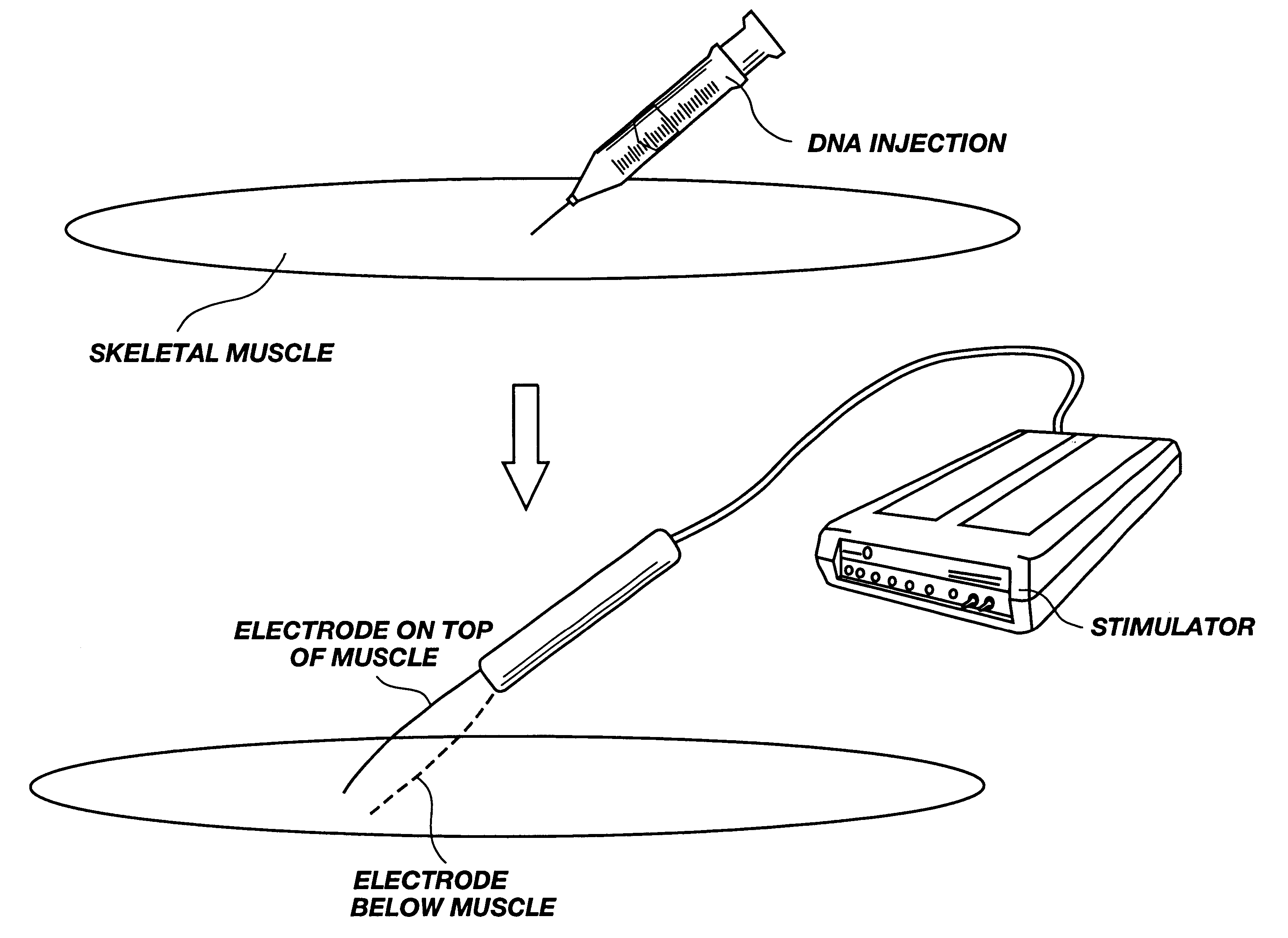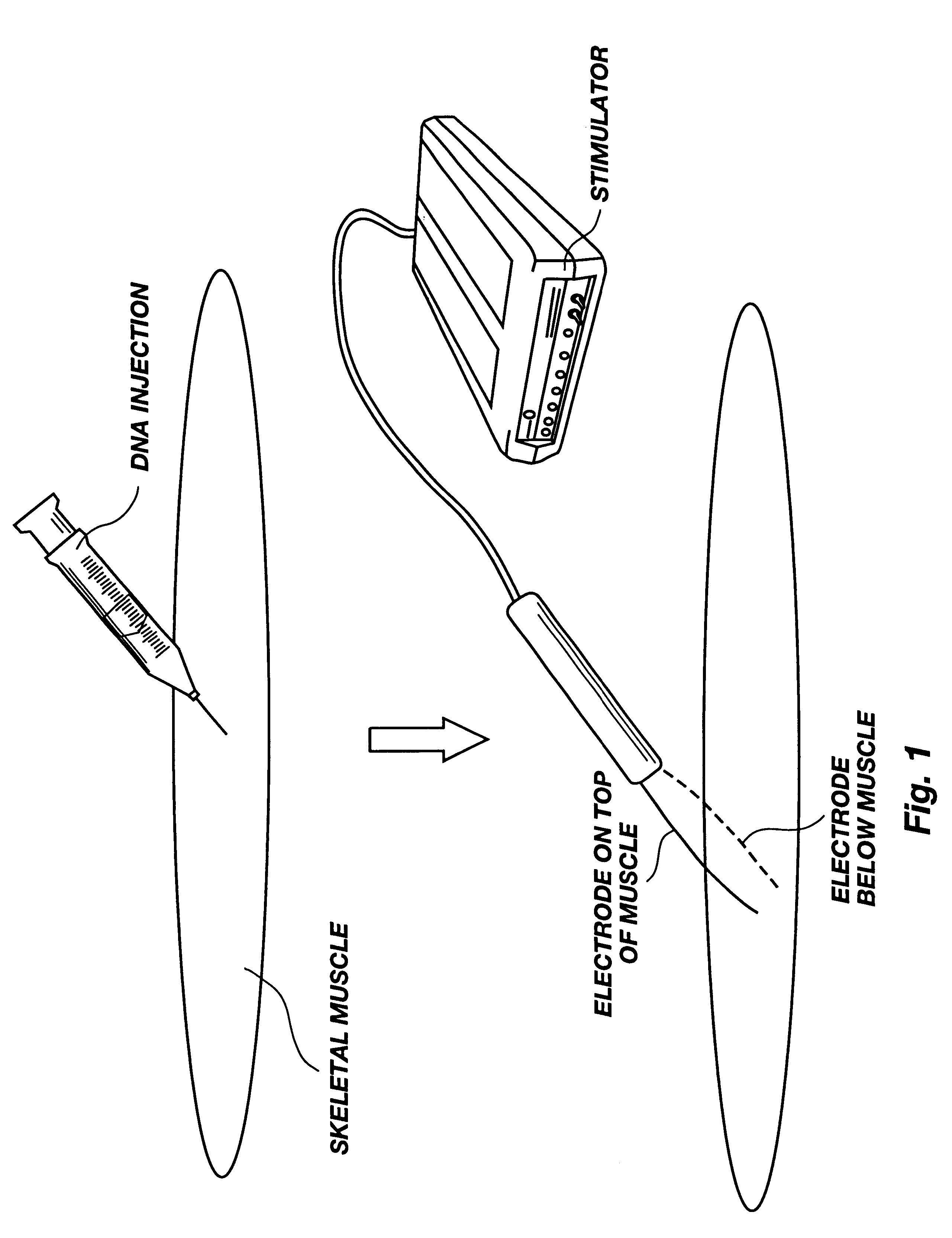Method for genetic immunization and introduction of molecules into skeletal muscle and immune cells
a technology of immune cells and molecules, applied in the field of genetic immunization and introduction of molecules into skeletal muscle and immune cells, can solve the problems of large percentage of orally or intravenously delivered drugs degraded by the body, no non-viral method of effectively delivering pharmaceutical drugs, proteins, dna into skeletal muscle in vivo, and no specific oral and intravenous drug and gene delivery, etc., to achieve greater luciferace activity, increase transfection efficiency, and voltage
- Summary
- Abstract
- Description
- Claims
- Application Information
AI Technical Summary
Benefits of technology
Problems solved by technology
Method used
Image
Examples
example 1
Stimulated Versus Unstimulated Muscles
Transfection efficiencies were determined by injecting skeletal muscles with the pSV40-luc reporter construct into the soleus muscle. Three days after injection, the muscles were removed and luciferace activity was measured using the Promega Luciferace Assay System (Madison, Wis.) according to manufacturer's protocols. Unstimulated EDL muscles from the same rats were used as control. The data are shown below in Table 1.
example 2
Transfection Efficiency Versus Frequency
Rats were injected with 50 .mu.l of 1 mg / .mu.l of a plasmid carrying lac Z gene. Immediately following injection, electrodes were placed between 2-3 mm apart and the muscle was stimulated with the following stimulation parameters: voltage=30 volts; pulse duration=0.2 ms (total 0.4 ms, bipolar); trains=30, 1 second on 1 second off for 1 minute. Transfected fibers were counted from a 1 mm slice from middle of muscle. The number of transfected fibers is shown below in Table 2 and illustrated in FIG. 7. These data also illustrate that the method of the present invention transfects more than just surface muscle fibers; muscle fibers several cell layers deep are also transfected.
example 3
Transfection Efficiency Versus Pulses
Soleus muscles of Wistar rats (200-270 grams) were injected with 50 .mu.g of RSV luciferace DNA plasmid in 50 .mu.l 0.9% NaCl. Shortly after injection, the muscles were electrically stimulated using the following parameters: 1000 Hz, between 0-1000 bipolar pulses of 200 .mu.s duration in each train were applied to the muscle 30 times over a period of 1 minute. Muscles were removed 3 days after transfection and frozen in liquid nitrogen. Cryostat sections were taken from the of the muscles and stained with Hematoxolin, Eosin and Safran (see Example 9). The remaining pieces were homogenized as described in Example 4 below. As illustrated in FIGS. 10-12, transfection efficiency increased with the number of pulses delivered to the muscle.
PUM
| Property | Measurement | Unit |
|---|---|---|
| time | aaaaa | aaaaa |
| time | aaaaa | aaaaa |
| time | aaaaa | aaaaa |
Abstract
Description
Claims
Application Information
 Login to View More
Login to View More - R&D
- Intellectual Property
- Life Sciences
- Materials
- Tech Scout
- Unparalleled Data Quality
- Higher Quality Content
- 60% Fewer Hallucinations
Browse by: Latest US Patents, China's latest patents, Technical Efficacy Thesaurus, Application Domain, Technology Topic, Popular Technical Reports.
© 2025 PatSnap. All rights reserved.Legal|Privacy policy|Modern Slavery Act Transparency Statement|Sitemap|About US| Contact US: help@patsnap.com



